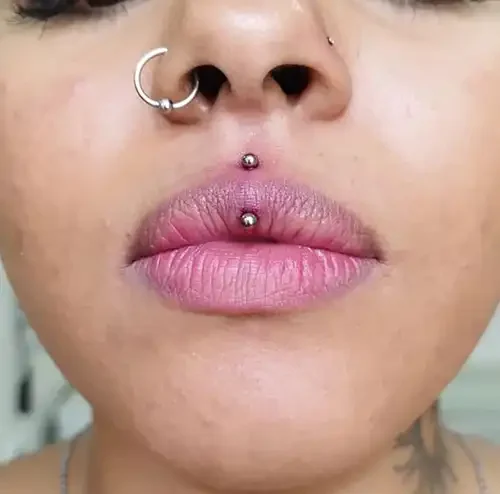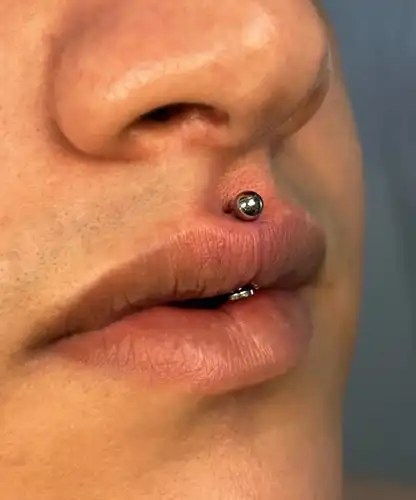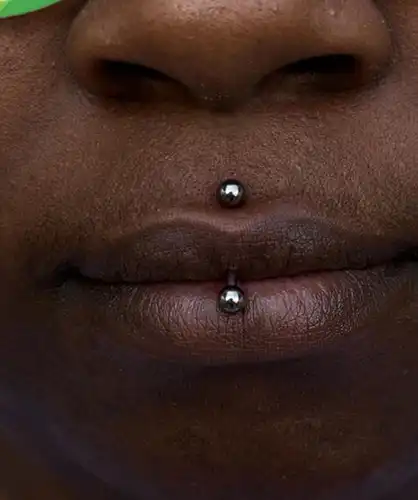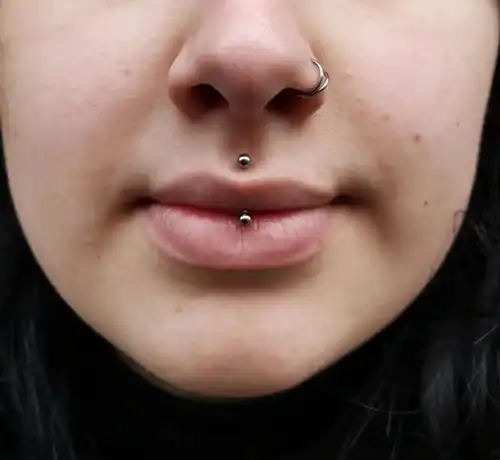Jestrum Piercing in Nairobi, Kenya
A Jestrum piercing, also known as a vertical medusa, is a type of lip piercing located in the philtrum area (the groove between the upper lip and the nose). Unlike a traditional medusa piercing, which is horizontal, the Jestrum piercing goes vertically through the center of the upper lip, with both ends of the jewelry visible—one end below the nose and the other on the upper lip.

Jestrum Piercing
Key Points about Jestrum Piercing:
- Jewelry: Typically, a curved barbell is used for this piercing. The ends of the barbell will usually have small beads or decorative ends.
- Healing Time: The healing process for a Jestrum piercing can take around 6-12 weeks, but this varies depending on individual aftercare and health.
- Pain Level: As with all piercings, pain is subjective, but the Jestrum is generally considered to be more painful than a simple lip piercing due to its location.
- Aftercare: Proper aftercare includes cleaning the piercing with saline solution, avoiding makeup around the area, and being cautious with activities that might irritate the piercing.
Jestrum Piercing Procedure
The Jestrum piercing procedure involves several steps to ensure safety and accuracy. Here’s a breakdown of what to expect:
- Consultation and Preparation:
– Consultation: Our piercer will discuss your desired placement, the type of jewelry, and any concerns you might have. They’ll also assess the anatomy of your upper lip to ensure that a Jestrum piercing is suitable.
– Sterilization: Our piercer will clean the area around your upper lip and nose with an antiseptic solution to reduce the risk of infection. The tools and jewelry will also be sterilized. - Marking the Placement: Our piercer will use a sterile marker to mark the entry and exit points of the piercing. This step is crucial for symmetry and accuracy. You will have the chance to review the placement in a mirror before proceeding.
- Piercing Process:
– Clamping (Optional): Some of our piercers may use a clamp to hold the upper lip in place, although this is not always necessary for a Jestrum piercing.
– Piercing: Using a sterile, hollow needle, our piercer will quickly insert the needle through the marked entry point just below the philtrum and exit through the upper lip. The process is swift, typically lasting only a few seconds.
– Jewelry Insertion: Our piercer will immediately follow the needle with the curved barbell jewelry, threading it through the new piercing. - Aftercare Instructions: Our piercer will provide you with detailed aftercare instructions, which usually include cleaning the piercing with saline solution and avoiding certain activities or products (e.g., touching the piercing with dirty hands, using harsh mouthwash).
- Post-Piercing Care: You might experience some swelling, redness, and tenderness for a few days after the procedure, which is normal. Ice packs or anti-inflammatory medication can help alleviate discomfort.
Considerations before getting a Jestrum Piercing
Before getting a Jestrum piercing, it’s important to consider several factors to ensure you’re making an informed decision. Here are the key considerations:
- Anatomy Suitability:
– Lip Structure: Not everyone’s anatomy is ideal for a Jestrum piercing. Our piercer will assess the shape and thickness of your upper lip and philtrum to determine if the piercing will heal properly and look symmetrical. - Pain Tolerance:
– Pain Level: The Jestrum piercing can be more painful than other lip piercings due to its placement through both the lip tissue and skin. Consider your pain tolerance and whether you’re prepared for potential discomfort during and after the procedure. - Healing Time and Aftercare Commitment:
– Healing Duration: Jestrum piercings typically take 6-12 weeks to heal but can take longer depending on your body’s healing process and how well you care for the piercing.
– Aftercare: You’ll need to commit to a strict aftercare routine, including cleaning the piercing twice daily with a saline solution, avoiding touching the piercing with unwashed hands, and steering clear of makeup, harsh skincare products, or activities that could irritate the area. - Lifestyle Impact:
– Work or School Policies: Consider whether your job, school, or other environments have rules against visible piercings. While the jewelry can be small and subtle, it’s still visible and may not be allowed in certain settings.
– Sports and Activities: If you’re involved in contact sports or activities that put your face at risk, you might need to avoid them during the healing period to prevent injury or complications. - Potential Risks and Complications:
– Infection: As with any piercing, there’s a risk of infection, particularly if aftercare is not followed properly. Signs of infection include excessive redness, swelling, pain, or discharge.
– Migration or Rejection: The body may push the jewelry out over time, leading to migration or rejection. This is more likely if the jewelry is too small or the piercing is not properly cared for.
– Scarring: There’s a possibility of scarring if the piercing is removed or doesn’t heal well. This is something to consider, especially since it’s on a visible part of the face. - Jewelry Choices:
– Material: High-quality, hypoallergenic jewelry (e.g., titanium, niobium, or surgical stainless steel) is essential to reduce the risk of allergic reactions or complications.
– Size and Style: Consider starting with a slightly longer barbell to accommodate initial swelling. After healing, you can switch to a shorter barbell for a snug fit. - Professionalism of the Piercer:
– Choosing a Reputable Piercer: It’s crucial to go to a professional, experienced piercer who follows strict hygiene practices. Research their portfolio, read reviews, and ensure they are using sterilized equipment and high-quality jewelry. - Financial Cost:
– Initial Cost: The cost of the piercing includes both the procedure and the jewelry. High-quality jewelry and professional service may be more expensive, but it’s worth the investment for your safety.
– Aftercare Products: You’ll also need to purchase saline solution or other aftercare products, which adds to the overall cost. - Long-Term Commitment:
– Maintenance: Even after healing, you’ll need to maintain the piercing to prevent issues. This includes cleaning the area regularly and potentially replacing the jewelry if it becomes damaged or no longer fits properly.
Considering these factors carefully will help you decide whether a Jestrum piercing is the right choice for you.
Pain and Healing for a Jestrum Piercing
Pain Level:
- During the Procedure:
– The Jestrum piercing is typically more painful than other lip piercings because it goes through both the skin and the thicker tissue of the upper lip. The pain is often described as a sharp, intense pinch that lasts only a few seconds.
– Pain levels vary from person to person depending on factors like individual pain tolerance, the skill of the piercer, and the use of a clamp (which can add to the discomfort). - Immediately After:
– After the piercing, the area may feel tender, throbbing, or slightly swollen. Some people report a sensation similar to a strong bruise or mild ache.
Healing Process:
- Initial Healing (First Few Days to Weeks):
– Swelling: Swelling is common during the first few days, and the area may feel tight or uncomfortable. Using ice packs and over-the-counter anti-inflammatory medications (like ibuprofen) can help reduce swelling and manage pain.
– Redness and Sensitivity: The area may appear red and feel sensitive to touch. Avoid touching or playing with the jewelry to prevent irritation or infection. - Intermediate Healing (2-6 Weeks):
– Crusting: As the piercing begins to heal, you may notice some crusting around the jewelry. This is normal and should be gently cleaned away with a saline solution.
– Tightness: You might experience tightness as the tissue heals, but the discomfort should gradually decrease over time. - Complete Healing (6-12 Weeks or Longer):
– Settling: By this stage, most of the initial symptoms (like swelling and redness) should have subsided. The piercing may still feel slightly tender if bumped, but it should be mostly healed.
– Changing Jewelry: It’s important to wait until the piercing is fully healed before changing the jewelry. If you experience any pain or resistance while changing the jewelry, the piercing may not be completely healed, and you should consult your piercer.
Tips for Reducing Pain and Promoting Healing:
- Choose a Skilled Piercer: A professional piercer will ensure the procedure is as quick and painless as possible, and they’ll use high-quality, hypoallergenic jewelry to minimize irritation.
- Follow Aftercare Instructions: Clean the piercing twice daily with saline solution and avoid harsh cleansers, makeup, or lotions near the area.
- Avoid Irritants: Be mindful of activities that could bump or irritate the piercing, such as sleeping on your face, playing with the jewelry, or eating spicy or acidic foods that could come into contact with the piercing.
- Stay Healthy: A strong immune system promotes faster healing. Stay hydrated, eat a balanced diet, and avoid smoking or alcohol, which can delay healing.
Signs of Healing Complications:
- Prolonged Swelling or Pain: If swelling or pain persists beyond the initial weeks or worsens, it could indicate an infection or other complication.
- Discharge: While some clear or slightly yellow discharge is normal, thick, greenish, or foul-smelling discharge is a sign of infection.
- Migration or Rejection: If you notice the jewelry shifting position or if the skin around the piercing appears thinner, it could be a sign of migration or rejection. Consult your piercer if this occurs.
By managing pain and following proper aftercare, you can ensure a smoother healing process for your Jestrum piercing.
Jestrum Piercing Aftercare
Proper aftercare is crucial for ensuring that your Jestrum piercing heals well and avoids complications like infection or rejection. Here’s a comprehensive guide to caring for your new piercing:
- Cleaning the Piercing:
Saline Solution: Clean the piercing twice a day using a saline solution. You can either buy a sterile saline solution or make your own by dissolving 1/4 teaspoon of non-iodized sea salt in 8 ounces of warm distilled water.
How to Clean:
→ Wash your hands thoroughly before touching the piercing.
→ Soak a clean cotton pad or gauze in the saline solution.
→ Gently press the pad against the piercing for a few minutes to soften any crusted material.
→ If needed, use a clean cotton swab to gently remove any debris around the jewelry.
→ Pat the area dry with a clean, disposable paper towel. Avoid using cloth towels as they can harbor bacteria. - Oral Hygiene:
– Mouth Rinse: Rinse your mouth with a saline or alcohol-free antimicrobial mouthwash after eating or drinking anything other than water, especially if the jewelry passes through the inside of your lip.
– Brushing Teeth: Brush your teeth twice daily, being careful to avoid irritating the piercing. Use a new, soft-bristled toothbrush to prevent bacteria from entering the wound. - Avoiding Irritants:
– Makeup and Skincare Products: Avoid applying makeup, lotions, or other skincare products near the piercing during the healing process. These can introduce bacteria or cause irritation.
– Touching the Piercing: Refrain from touching or playing with the jewelry, as this can introduce bacteria and cause irritation or injury.
– Avoid Oral Irritants: Limit your intake of spicy, acidic, or salty foods, as these can irritate the piercing. Avoid smoking and alcohol, which can slow down the healing process. - Managing Swelling and Pain:
– Cold Compress: Use a clean cold compress or ice pack wrapped in a cloth to reduce swelling during the first few days. Apply it to the outside of your upper lip for short intervals.
– Anti-Inflammatories: Over-the-counter anti-inflammatory medications, like ibuprofen, can help reduce swelling and manage pain. - Lifestyle Adjustments:
– Sleeping Position: Sleep on your back to avoid putting pressure on the piercing. Elevating your head with an extra pillow can also help reduce swelling.
– Clothing and Activities: Be mindful of activities that might bump or catch on the piercing, such as contact sports or wearing tight clothing around the face. Avoid swimming in pools, hot tubs, or natural bodies of water until the piercing is fully healed. - Jewelry Considerations:
– Avoid Changing Jewelry Early: Do not attempt to change the jewelry until the piercing is fully healed (typically 6-12 weeks). If you need to change it sooner, consult your piercer.
– Check Jewelry Fit: If the initial jewelry feels too tight or becomes embedded in the tissue due to swelling, see your piercer immediately. They may need to replace it with a longer barbell to accommodate the swelling. - Signs of Infection or Complications:
– Infection: Look out for signs of infection, including increased redness, swelling, warmth, throbbing pain, or pus-like discharge that is green or yellow and foul-smelling. If you suspect an infection, consult your piercer or a healthcare professional.
– Migration or Rejection: If the jewelry appears to be moving closer to the surface or if the skin around the piercing becomes very thin, it could be a sign of migration or rejection. Visit your piercer if you notice these signs. - When to Seek Professional Help:
– If you experience severe pain, excessive swelling, or any signs of an allergic reaction (e.g., itching, rash, or difficulty breathing), seek medical attention immediately.
– For any concerns about healing, jewelry issues, or aftercare, it’s always best to consult our piercer rather than attempting to fix the problem on your own.
By following these aftercare steps, you can promote proper healing and reduce the risk of complications with your Jestrum piercing.
Jestrum Piercing Jewelry
Choosing the right jewelry for your Jestrum piercing is crucial for both comfort and healing. Here’s a guide to help you understand the options and make an informed decision:
Initial Jewelry:
- Curved Barbell: The most common and recommended jewelry for a Jestrum piercing is a curved barbell. The curved shape follows the natural contour of your upper lip, reducing stress on the piercing and allowing for more comfortable movement.
- Material:
– Titanium: Lightweight and hypoallergenic, titanium is often recommended for initial piercings because it minimizes the risk of allergic reactions and is highly resistant to corrosion.
– Niobium: Another hypoallergenic metal, niobium is similar to titanium but slightly heavier. It’s a good option for those with metal sensitivities.
– Surgical Stainless Steel: While commonly used, some people may be sensitive to the nickel content in stainless steel. It’s durable but might not be ideal for those with metal allergies. - Size:
– Gauge: Jestrum piercings are typically done with a 16 or 14-gauge needle, meaning the jewelry should match this size.
– Length: The initial jewelry should be slightly longer (around 8-12mm) to accommodate swelling. Your piercer will select the appropriate length based on your anatomy and anticipated swelling.
Jewelry for Healed Piercings:
Once the piercing is fully healed (usually 6-12 weeks), you may want to switch to a shorter curved barbell for a snug fit. Consult our piercer before making any changes to ensure the piercing is ready for new jewelry.
- Decorative Ends:
– Beads: The standard ends are beads, which can be simple or decorative.
– Gems: Many opt for small, gem-set beads for a bit of sparkle. Ensure that any gems are securely set to avoid irritation.
– Discs or Cones: Flat discs or pointed cones offer alternative aesthetic choices. Make sure the ends are smooth and not too sharp to avoid injury to the lip or teeth. - Customization and Styles:
– Colors: Titanium and niobium can be anodized in various colors without compromising the metal’s hypoallergenic properties. Choose a color that complements your style while ensuring the metal quality is high.
– Design: Beyond simple beads, you can choose custom designs or decorative elements like opals, pearls, or intricate shapes. Just ensure that any additional decorations don’t add unnecessary weight or cause irritation. - Jewelry Maintenance:
– Regular Cleaning: Even after healing, it’s important to clean your jewelry regularly to prevent buildup of plaque or debris. Remove the jewelry periodically (after the piercing is fully healed) for a thorough cleaning.
– Check for Damage: Inspect the jewelry regularly for signs of wear, such as scratches, loose threads, or damage to decorative ends. Replace any damaged jewelry promptly to avoid irritation or injury. - Where to Purchase:
– Reputable Piercing Studios: It’s best to purchase jewelry from the piercing studio where you got the piercing, as they can ensure the jewelry is the correct size and material.
– Specialty Online Stores: If buying online, choose stores that specialize in body jewelry and provide detailed information about the materials and manufacturing process.
Choosing the right jewelry is key to a successful Jestrum piercing experience. High-quality, well-fitted jewelry can make the healing process smoother and keep your piercing looking great long-term. If you need recommendations on where to purchase specific types of jewelry, we can help with that too. Contact Us to speak with one of our professional piercers.
Cost of a Jestrum Piercing in Nairobi, Kenya
The cost of a Jestrum piercing can vary widely depending on several factors, including location, the experience of the piercer, jewelry choice, and the studio’s reputation. Understanding these factors can help you budget appropriately and ensure you receive a safe and professional piercing experience.
Factors Influencing the Cost
- Location
– Geographic Area: Urban areas and cities typically have higher prices compared to rural locations due to higher operating costs and demand.
– Country-Specific Pricing: Economic factors and standard pricing in different countries affect the overall cost. - Piercer’s Experience and Reputation
– Experienced Professionals: Highly experienced and reputable piercers may charge more for their services, reflecting their skill level and quality assurance. At Rebel Inks Tattoos, Tattoo Removal, and Body Piercings Parlour we have experienced professionals who offer quality and premium services.
– Studio Reputation: Well-established studios with strict hygiene standards and excellent customer reviews often have higher pricing.
Jewelry Selection
- Material Quality: High-quality, hypoallergenic materials like titanium, niobium, or solid gold increase the cost.
- Design Complexity: Custom or intricate jewelry designs, as well as pieces featuring gemstones or unique embellishments, will be more expensive.
- Initial vs. Replacement Jewelry: Initial piercing jewelry often needs to be of superior quality to promote healing, contributing to a higher upfront cost.
Additional Services and Products
- Aftercare Products: Saline solutions, antiseptics, and other recommended aftercare products may be sold separately, adding to the total cost.
- Consultations and Follow-ups: Some studios include consultation and follow-up checkups in the initial price, while others charge separately.
- Taxes and Tips: Don’t forget to account for sales tax and gratuity where applicable.
Breaking Down the Costs
- Piercing Fee:
– Covers the service provided by the piercer, use of sterilized equipment, and the procedure itself.
– Average range: Ksh. 3,000 to Ksh. 5,000 - Jewelry Cost:
– Depends on material, design, and quality.
– Basic titanium or surgical steel jewelry: Ksh. 300 to Ksh. 1,000
– Premium materials (solid gold, platinum) or custom designs: Ksh. 2,000 to Ksh. 5,000 - Aftercare Products:
– Saline solutions and cleaning products: Ksh. 300 to Ksh. 500 - Additional Fees:
– Some studios may charge for initial consultations or follow-up appointments if not included.
– Replacement jewelry or downsizing after initial healing may incur extra costs.
Jestrum Piercing Estimated Cost Table
Component / Package | Estimated Cost (KSh) | Details / Notes |
Procedure + basic jewelry (starter curved barbell) | 1,500 – 2,500 | Estimated via vertical labret cost |
Premium jewelry upgrade (titanium, gold, etc.) | 300 – 2,500 | Based on jewelry cost ranges |
Aftercare kit (saline sprays, wipes) | 500 – 1,000 | As listed for other facial piercings |
Total (Basic Package) | 1,500 – 2,500 | Includes procedure + starter jewelry |
Total (With Upgrades & Care) | 2,300 – 6,000 | Includes premium jewelry and aftercare supplies |
Why Quality Matters
- Safety and Hygiene: Paying more for a reputable piercer and high-quality studio ensures better hygiene practices, reducing the risk of infection and complications.
- Proper Healing: Quality jewelry made from appropriate materials is crucial for proper healing and minimizing allergic reactions.
- Experience and Skill: Experienced piercers are more likely to perform the procedure correctly, ensuring proper placement and reducing the risk of issues like scarring or rejection.
Choosing a piercer based solely on low cost can lead to poor outcomes and additional expenses down the line due to complications or improper healing.
Tips for Managing Costs
- Research and Compare: Look up multiple piercing studios in your area, compare their prices, reviews, and portfolios.
- Consultations: Schedule consultations to discuss pricing, procedures, and any concerns you may have. Some studios offer free consultations.
- Inquire About Packages: Some studios offer package deals that include the piercing, jewelry, and aftercare products at a discounted rate.
- Budget for Quality: Allocate enough budget to prioritize quality over cost. It’s better to wait and save up for a reputable service than to risk complications from a cheaper, less professional option.
- Ask About Follow-Up Services: Ensure you understand what follow-up services are included and what additional costs may arise during the healing process.
Questions to Ask Your Piercer
- What is included in the total cost?
- What type of jewelry materials do you use?
- Do you offer aftercare products, and are they included in the price?
- What is your experience with Jestrum piercings?
- Do you provide follow-up checkups, and are there additional fees?
- What payment methods do you accept?
Investing in a high-quality piercing experience is essential for your health, safety, and satisfaction with the result. Always prioritize professionalism, cleanliness, and quality materials over cost savings. Take the time to research and choose a reputable studio and piercer who can provide the best care and outcome for your Jestrum piercing.
Would you like more information on finding reputable piercing studios or preparing for your appointment? Contact Us to speak with one of our piercing experts





Possible side effects of Jestrum Piercing
While a Jestrum piercing can be a unique and stylish choice, it’s important to be aware of the potential side effects and risks associated with it. Here are some of the possible side effects:
- Swelling and Bruising:
– Initial Swelling: It’s common to experience swelling immediately after getting the piercing. The upper lip may appear puffier than usual for several days to a couple of weeks.
– Bruising: Some bruising around the piercing site is also normal, especially if the tissue is sensitive or if blood vessels are close to the surface. - Pain and Tenderness:
– Pain During and After Piercing: The piercing process itself can be painful, and you may experience tenderness or a dull ache for several days post-procedure.
– Prolonged Tenderness: If the pain persists or intensifies, it could indicate an issue such as irritation, infection, or improper jewelry placement. - Infection:
– Signs of Infection: Infections can occur if the piercing is not properly cared for. Symptoms include excessive redness, warmth, swelling, throbbing pain, pus-like discharge (especially if it’s green or yellow), and a foul odor.
– Prevention: Follow aftercare instructions diligently, keep the area clean, and avoid touching the piercing with unwashed hands to minimize the risk of infection. - Migration and Rejection:
– Migration: The jewelry may shift from its original position as the body gradually pushes it outward. This can result in an uneven appearance or discomfort.
– Rejection: In more severe cases, the body may reject the piercing entirely, pushing the jewelry out completely. This usually results in scarring.
– Signs: If you notice the jewelry moving closer to the surface of the skin or the hole enlarging, consult your piercer immediately. - Scarring and Keloids:
– Hypertrophic Scarring: Raised, red, or dark scars may develop at the piercing site if the body produces excess scar tissue.
– Keloids: Some people may develop keloids, which are larger, more pronounced scar tissues that can grow beyond the piercing site. These are more common in individuals with a predisposition to keloid formation.
– Prevention and Treatment: Following proper aftercare can help minimize the risk of scarring. If keloids or other scars develop, consult a dermatologist for treatment options. - Tooth and Gum Damage:
– Gum Recession: If the jewelry rubs against your gums, it can cause them to recede, exposing the roots of your teeth and leading to sensitivity and potential tooth loss.
– Tooth Damage: Repeated contact with the jewelry can chip or crack your teeth, especially if the jewelry is large or made of a hard material.
– Prevention: Opt for well-fitted jewelry made of a biocompatible material, and avoid playing with the jewelry inside your mouth. - Lip and Facial Nerve Irritation:
– Nerve Damage: Improperly placed piercings can potentially irritate or damage nerves, leading to numbness or a tingling sensation in the lip or surrounding area.
– Lip Movement Issues: In some cases, the piercing can cause difficulty with certain facial expressions, speaking, or eating due to irritation or swelling. - Allergic Reactions:
– Nickel Allergy: If the jewelry contains nickel, those with a nickel allergy may experience redness, itching, and swelling around the piercing site.
– Material Sensitivity: Even high-quality metals like titanium or gold can cause allergic reactions in some individuals.
– Prevention: Choose hypoallergenic jewelry made from materials like titanium, niobium, or implant-grade stainless steel. - Difficulty Healing:
– Prolonged Healing: The Jestrum piercing passes through two layers of tissue, making it more complex and potentially slower to heal. Healing times can extend beyond the usual 6-12 weeks if the piercing is irritated or if aftercare is not followed properly.
– Hypergranulation: Overuse of cleaning products or excessive moisture can lead to hypergranulation, where tissue overgrows around the piercing site, causing a raised, red bump. - Embedding:
– Jewelry Embedding: If the initial jewelry is too short or if excessive swelling occurs, the jewelry may become embedded in the lip tissue, causing pain and potential infection.
– Treatment: Immediate consultation with your piercer is necessary to replace the jewelry with a longer barbell if embedding occurs. - Speech and Eating Difficulties:
– Speech: The presence of the jewelry may temporarily affect speech, causing a lisp or difficulty pronouncing certain words until you get used to it.
– Eating: Eating may be challenging initially, especially with hard, sticky, or acidic foods that could irritate the piercing. - Aesthetic Concerns:
– Asymmetry: If the piercing is not perfectly centered or if it migrates, it could result in an uneven appearance, which might be aesthetically displeasing.
– Scarring: Even after removal, the piercing might leave a noticeable scar or indent on the upper lip. - Emotional and Social Impact:
– Perception: Visible facial piercings might be frowned upon in certain professional or social settings. This could impact your personal or professional life, depending on your environment. - Minimizing Risks:
– Choose a Professional Piercer: Always go to a reputable, experienced piercer who follows strict hygiene practices.
– Follow Aftercare Instructions: Proper aftercare is essential to minimize the risk of complications.
– Listen to Your Body: If something feels off or you notice any unusual symptoms, don’t hesitate to consult your piercer or a healthcare professional.
Being aware of these potential side effects can help you make an informed decision and prepare for the piercing experience.
Get In Touch
For more information on the list above and any other special services,please call or come in for free consultation
Testimonials
I am extremely happy with my new 'Safari' tattoo from Eric at Rebel Inks! The quality of the artwork is fantastic. Eric is a true professional and an amazing artist.
The preparation and design process was thorough and collaborative. He was very patient with my specific requests, including making sure all the elements, which hold personal meaning, were perfect.
The service was friendly and highly professional from start to finish. Despite the 8-hour session, Eric was a pleasant person to spend the time with.
The aftercare guidance and follow-up have been excellent and careful, which has made the healing process easy and better than expected.
I highly recommend Eric for anyone looking for a thoughtful, talented, and caring tattoo artist.
I recommend them 💯
I would definitely recommend if you’re thinking of getting a piercing!
The staff were super friendly, explained everything clearly, and made me feel so at ease. They answered all my nervous questions (and I had many questions),
They walked me through the whole process, gave detailed aftercare instructions, and even followed up afterward to check how I was healing 🫶
Clean, professional, and full of good vibes.
Would 100% recommend . Definitely making a second trip here.
This was the second tattoo I got and I wish I could have come to Eric for my first one! He gave me really great after-care directions for the tattoo as well as a little jar of his own Vaseline-type stuff to put over my tattoo while it was healing! He even put second skin over my tattoo so that I didn’t have to worry about it for the first few days. Now THAT’S good service. My first tattoo artist didn’t do none of that lol.
After the session Eric didn’t rush me and my friend out, he chatted with us and even when he found out I was an artist too— really encouraged me to keep creating and to find a community of artists to support me. I almost cried because I’ve had such a hard time with my own art the past couple of years, it meant so much to me to have a fellow very talented artist say that to me. 🤍🤍🤍
Eric you’re amazing, don’t ever stop creating and just know you’ve impacted lives all over the world!🫶🏻 thanks so much for everything!!
From the moment I walked in, Eric was professional, welcoming, and attentive. He made sure I was comfortable throughout, provided everything I needed, and explained every step of the process. The tattooing itself was unbelievably smooth - I genuinely felt no pain compared to my previous tattoos over the last 22 years.
Eric also gave me excellent aftercare guidance and products, and thanks to that, my tattoo healed beautifully. The attention to detail, precision, and shading are absolutely stunning. This is hands-down the best tattoo I've ever had, and I will be flying back to Nairobi for any future ink.
If you want incredible art, a professional experience, and a talented artist who truly cares about his clients, Rebel Ink is the place to go!
From start to finish, the service was exceptional. The piercer was professional, knowledgeable, and made me feel completely comfortable. The cleanliness of the place was above and beyond — everything was spotless and hygienic, which really put me at ease. Highly recommend for anyone considering a piercing!
Shout out to Eric😘
We ended up changing the jewelry three times to ensure I had the best fit and avoided any signs of rejection, and he always listened to my suggestions as a client, which I really appreciated. Now, three months in, my piercing is healing beautifully, with no sign of rejection. Highly recommend for anyone who values a piercer who cares about your comfort and healing journey!
What stood out the most was the aftercare Eric checked in with me even three weeks later to see how the tattoo was healing. That kind of follow-up shows how much he truly cares about his work and his clients.
I’m very satisfied and will definitely be coming back for my next piece. Highly recommend!
The piercing wasn't as painful as I had thought and the process was quick and satisfactory. I love it!!!
The piercing is healing well thanks to the aftercare instructions and follow-up. I would highly recommend Rebel Inks
Eric also did a belly button piercing for a friend, guiding her through the process, doing the piercing and then explaining the after care to her.
The shop is on the 3rd floor, with the entrance to the stairs near an alleyway on the left. The shop is perfect size, clean, and attractive looking. The mural is pretty dope.
Thank you for the amazing service! 🔥👅✨
I got piercibgs there and the process was really good. My biggest concern was hygiene but that wasn't an issue at all, they use new needles and they sanitize them.
The service itself was also welcoming.
I was informes of everything i needed to know beforehand.
10/10 would recommend!
Eric was so calm and patient with my almost 2 year old lady. It was such a clean and hygienic process. We will definitely be back for our second rounds of piercings and maybe even another tattoo!
They assess the area before any art and advise one accordingly. They also give one post clean up process and also do a check up after the body art projects. Overall, I loved my experience and I’m hooked. 👍
Will definitely come back next time I’m in town 🙂
He listened to what I actually wanted and made sure he could fit in the time before I flew back home.
The shop is clean & private and is easy enough to find.
Eric has even checked in a couple of times since to make sure all is good.
I would totally recommend Eric! I absolutely love my Elephants!
I had a very easy healing period and always follow up from Eric to check on my progress...I would highly recommend if you are a first timer because from my experience all went very well and attention to detail
Thank you for a good job and looking forward to send all my friends your way
And all the best with the new year 2025!
From the moment I walked in, the staff was super friendly and made me feel at ease. The studio had a clean, professional atmosphere, which immediately put me at ease. My piercer was incredibly skilled and explained every step of the process, ensuring I was comfortable the entire time. The piercing was quick and practically painless, and the aftercare instructions were clear and easy to follow. I can tell they really care about the health and safety of their clients.
Overall, a fantastic experience—I highly recommend Rebel Inks and Tattoos for anyone looking to get pierced or tattooed!
They do follow up after their services
Eric's Studio isn’t just a place to get a tattoo—it’s an experience. The combination of professionalism, artistic talent, and a welcoming environment makes it a standout destination for anyone considering a tattoo.
I highly recommend Eric’s Studio to both first-timers and seasoned tattoo enthusiasts. If you’re looking for a high-quality tattoo and an enjoyable experience, this is the place to go.
I would definitely recommend their services again and again
Thank you Rebel Ink
My piercings are healing ❤️🩹 well
I would 💯 recommend
I will definitely come back for more .
Two, all the equipments he used for the piercings were new and/or sterilised.
Three, the parlour itself was very clean and was up to par with the hygiene standards.
Four, Eric provided effective aftercare instructions, making sure I knew exactly how to take care of my new piercings and he kept in touch and continues to do so, to check on the healing progress.
I highly highly highly recommend this place!!!
Would definitely recommend them to friends and go back for other piercings
Not only was the piercing process smooth, but he also provided thorough aftercare instructions, making sure I knew exactly how to take care of my new piercings. What really impressed me was that he keeps in touch to check on how the healing is progressing – a sign of true care for his clients.
The shop maintains a high standard of hygiene, and the atmosphere is welcoming and comfortable, which really added to the positive experience. I highly recommend this place to anyone looking for a professional and caring experience. I’ll definitely be coming back for any future piercings!
My appreciation for the excellent customer service I received. The follow-ups were prompt, and I truly appreciated the gentleness and professionalism throughout. Thank you!"
"Looking for professional eyebrow microshading removal? Look no further!"
The customer care is top tier 👌🏾👌🏾.
Wonderful place to get tattoos and piercings. 💯💯
Eric goes ahead to follow up on his clients progress and gives good advice each time I reach out to him.
I would recommend Reble tattoos anytime.
Good job bro we really appreciate.
Ohh and the price is very fair.
The environment was clean , procedure was sterile and the jewelry used are of the best quality.
He followed up with me during the healing process, he educated me on what I needed to do for my aftercare.
Eric is confident, skilled , experienced and the best piercer. Highly recommend Rebel inks.✨
Definitely recommend!
Great experience.
Eric definitely know what he is doing .
I got exactly what I wanted 2 tiny tats on the same finger .
He was kind and patient throughout the session.
Healing process has been good .
Aftercare services were given and regular checkups on the healing process were done.
I would 💯recommend.
Eric gave me the best reception as it was my first time there,and made me trust him all the way. I appreciate good services.
There services are also affordable not to forget 😊.
He was also invested in the aftercare and would ensure I follow the do's and don'ts in taking care of the tattoo and ensuring proper healing and maximum ink retention.
Would highly recommend Rebel Inks Tattoos.
Rebel Inks Tattoo offer the best,affordable and quality tattoo removal services.If you have unwanted ink,choose Rebel Inks Tattoo,they're the best of the best and the professionalism is a top notch.They ensure you're free from unwanted ink with their Laser Tattoo Removal Technology...
I did a Laser Tattoo Removal with them and i can attest they're the best....
Kudos Eric...
I highly recommend.
It was a generally good experience with good hygiene during the piercing process and has been a smooth healing process.... 10/10
tips. Highly recommend 👍🏽
100% recommendable.
I was particularly impressed with Eric's attention to hygiene. He thoroughly cleaned the room before I entered, sanitized all of the equipment he would be using, and changed gloves between each ear. This level of cleanliness gave me great confidence in his professionalism.
Eric's commitment to customer service did not end on the day of the piercing. He followed up with me regularly throughout the healing process to ensure that I was following the aftercare instructions and that my earlobes were healing properly.
I highly recommend Rebel Inks to anyone in Nairobi who is considering getting a piercing. Eric is a highly skilled and experienced piercer who takes great pride in his work.
So I Check all the boxes below and more:
Customer Care: ✔️
Professionalism : ✔️
Cleanliness ✔️
Price: ✔️
After care service ✔️
Thanks and good job, Eric
The place is neat and clean and the equipments he used were also fine standards. Really appreciate his following up with me on the healing 🤗
I WOULD HIGHLY RECOMMEND THEIR SERVICES to everyone. Actually what you see on their website is EXACTLY what you will get. Keep up the good work Rebel inks Tattoos.
The infection is now gone. I would definitely recommend!
Can recommend this place totally and would go back there anytime!
Thanks!
OUR LOCATION
Areas We Serve
NAIROBI
KIAMBU
KAJIADO
MACHAKOS




































































































































































































































